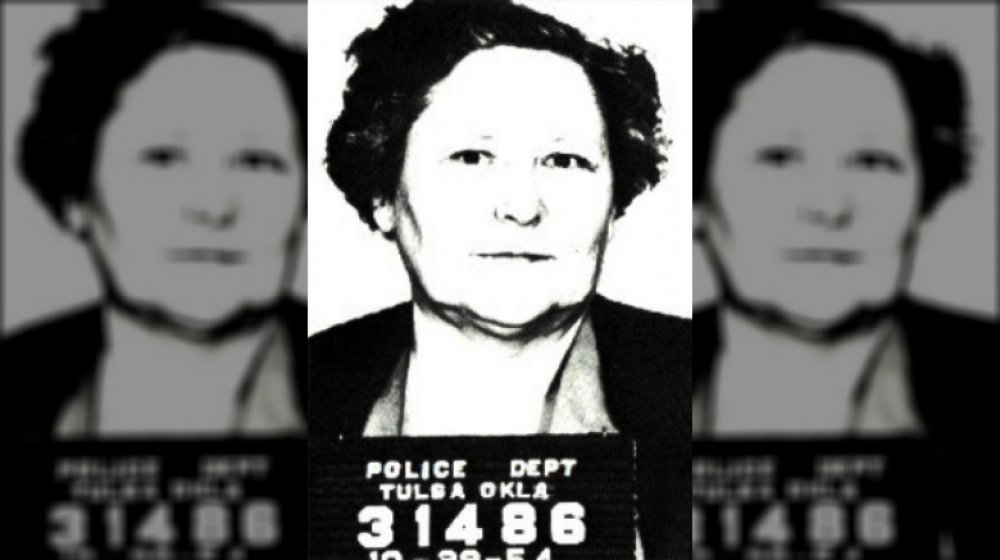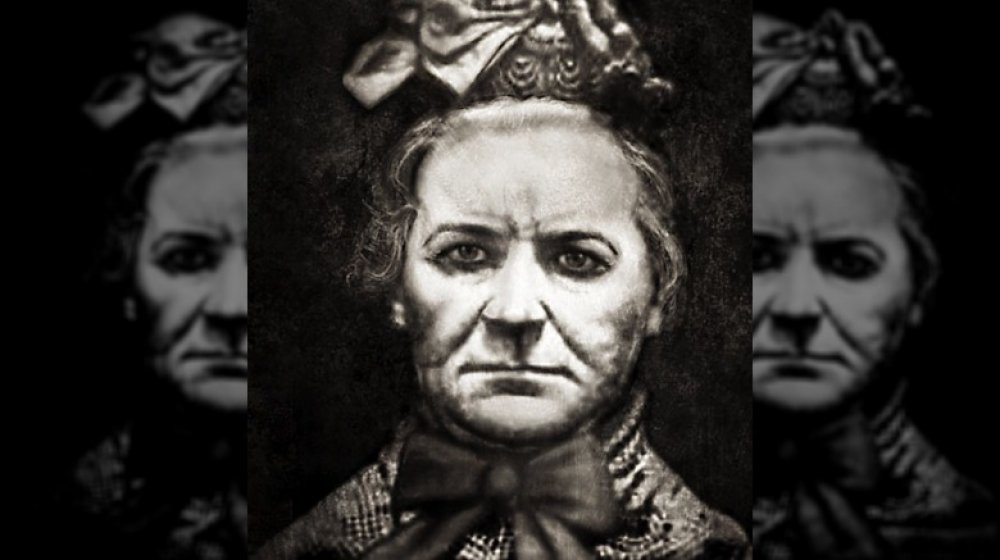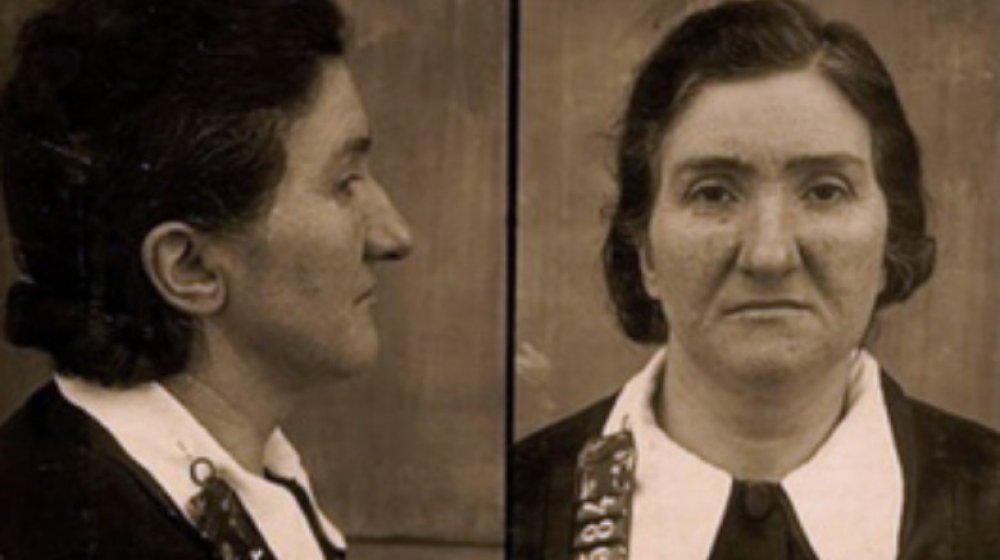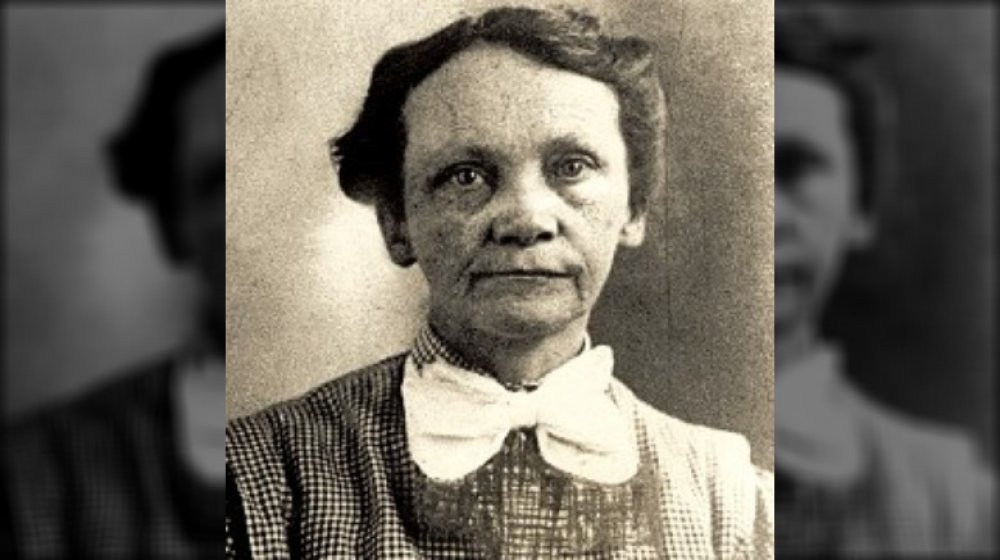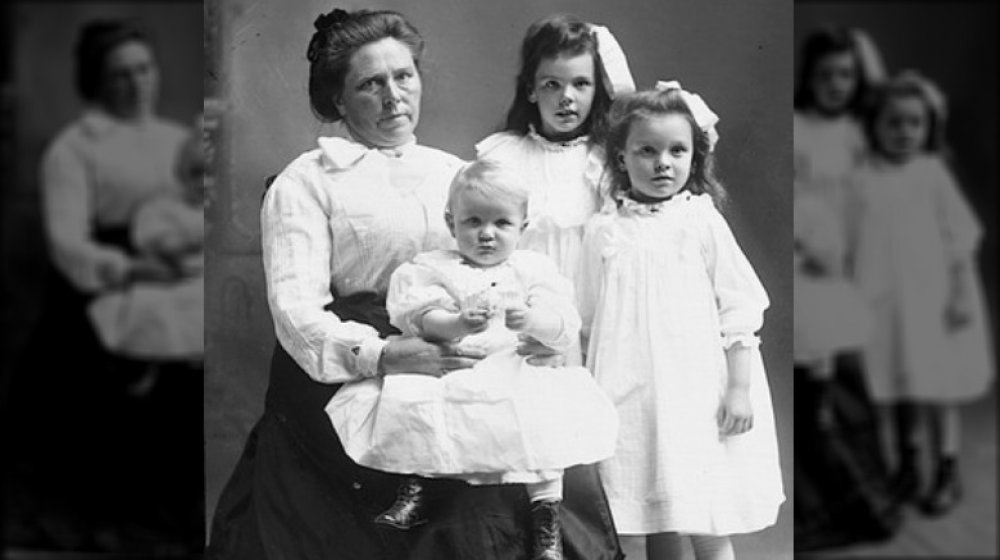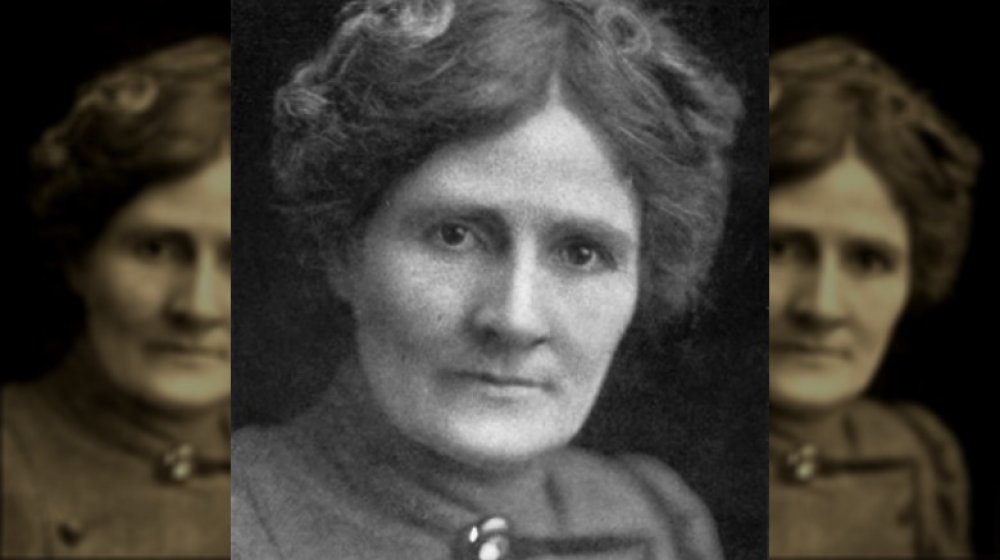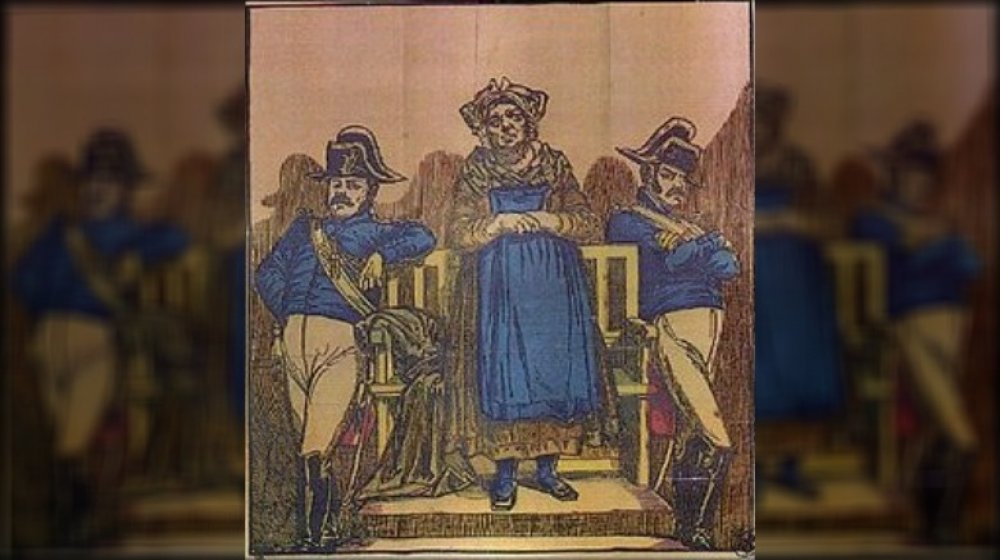The Most Notorious Female Serial Killers
For generations, women have been seen as kinder, gentler, and more nurturing than men, rightly or wrongly. That might be why when we think of serial killers, we think of men. Dahmer, Bundy, Gacy, Rader ... they're all notorious names (unfortunately for anyone who happens to share those names), but to think that all serial killers are men is absolutely wrong.
It's also wrong to think that all female killers rely on poison, that they don't like to get their hands bloody, or that they confine their killing only to their families. Some certainly do, but others? Well, let's just say there's more than one female ax murder out there, and there's also a whole lot of creativity when it comes to modus operandi. Even though they don't seem to get as much media attention, the world is full of bloodthirsty women, and today, we're taking a look history's most notorious female serial killers.
Nannie Doss was called 'the Jolly Black Widow'
Nannie Doss was known by nicknames like "the Jolly Black Widow" and "the Giggling Granny," and her killing spree started in the 1920s and only ended in 1954. According to ThoughtCo., the Alabama-born Nancy Hazle didn't have a great start in life, as she faced living with a man who was more dictator than father. In fact, her father forbade her to even speak to a boy until she turned 21, so it's not entirely surprising that she married a man within five months of meeting him.
As you might guess, things quickly went downhill. They had three children in three years — years controlled by a manipulative mother-in-law and an abusive, constantly drunk husband. After the birth of their fourth, the two middle children died. The official cause was food poisoning, but her husband — suspecting actual poison — took off with their oldest. And he ended up being the only husband she didn't kill.
She met her second husband through a lonely hearts column, and their marriage lasted an impressive 16 years until ... well, you know. It wasn't until 1943 that her newborn granddaughter died mysteriously, and her daughter — only semi-conscious post-delivery — swore she saw her mother stab the baby with a hatpin, but there was never proof. More children and grandchildren died "mysteriously," and it wasn't until her fifth husband (who was a fine, upstanding man) died that an autopsy was ordered, and it was found he had a stomach full of arsenic. Her estimated death toll was 11, and in 1965, she died in the Oklahoma State Penitentiary, reports Tulsa World. The cause? Leukemia.
Amelia Dyer was the world's worst baby farmer
Being a baby farmer sounds like a terrible thing, but the idea wasn't. It was simply a person who would take in and care for the unwanted children of others. Unfortunately, the truth was often hard, and according to the Ultimate History Project, many of these early foster care babies died of neglect and abuse.
Then, there was Amelia Dyer.
Dyer was born in a small English town in 1837, and according to family members (via History Collection), she was never quite the same after she contracted typhus as a child. She was violent, and perhaps unsurprisingly, it wasn't long before she was estranged from her family. She trained as a midwife and a nurse, eventually running a boarding house for pregnant women. Many paid for her assistance in the delivery, then left their babies in her care.
It was standard enough stuff, but fast forward a bit to March 30, 1896. That, says the BBC, is when a package was fished out of the Thames. Inside was the body of a baby, a little girl who'd been strangled with a piece of white tape.
Fortunately, the packaging the baby had been wrapped in contained some vital clues, including stamps and an address. That pointed authorities in Dyer's direction, and when they found themselves investigating a woman already known to doctors as having a suspicious number of babies die while in her care, well, that was that. She was arrested and, just a few months later, hanged, after killing upwards of 300 children.
Meet Miyuki Ishikawa, aka the Demon Midwife
Life in Japan was difficult in the years after World War II, and those were years that a midwife named Miyuki Ishikawa decided to take it upon herself to make peoples' lives easier.
According to Absolute Crime, she worked at the Kotobuki maternity hospital, and she was responsible for the deaths of between 103 and 169 children. Women would give birth, couples would be in a bad financial situation ... and she would convince them that it would be cheaper to pay her and her colleague, Dr. Shiro Nakayama, a decent sum of money rather than take their children home to raise them. False death certificates were drawn up, and it wasn't until January 12, 1948, that anyone was any bit the wiser. That was when two police officers discovered the suspicious remains of five children, and the investigation that followed not only led to the hospital and the midwife but to 70 more bodies.
During the trial, it was argued that the parents were to blame — they'd abandoned their children, after all. And it was an argument that was strangely well received. Ishikawa was handed an eight-year jail sentence, and she ended up appealing to get that cut in half.
Clementine Barnabet was a Louisiana ax murderer
The ax killings started in November 1909, with the murder of a woman and her three children in Rayne, Louisiana. Next was a couple and their son, then, four members of another Louisiana family. And so on and so on.
Eventually, police zeroed in on Raymond Barnabet. He was already a figure with a shady past, but when another family was killed while he was in custody, it was clear that he wasn't the guilty party ... even though his children, Zepherin and Clementine, had testified they had seen him covered in blood and heard him bragging he'd killed a whole family (via Mental Floss).
Police went back to investigate, and they arrested Clementine when they found blood and brains on some of her clothes. Still, the murders continued, and in 1912, Clementine made a confession (via The New York Times). She was a part of the Church of Sacrifice, a voodoo cult that believed sacrificing the lives of others would grant immortality, and that they would be protected by their charms.
And this is where things get extremely confusing. She confessed first to 17 murders, then to 35, but the evidence suggests while she was guilty of some, she didn't do all the killings alone. The events surrounding the so-called Church of Sacrifice remain a little cloudy. As for Clementine, she underwent a "procedure" of some sort, and she was released after ten years in jail.
Leonarda Cianciulli was a female serial killer who enjoyed making soap
Leonarda Cianciulli was born in southern Italy in 1894. She was well-liked and popular, says the BBC, but she was also incredibly superstitious. At the heart of her superstition was, Gizmodo reports, a fortune teller's prophecy that all of her children would die. And it was nearly true. Of her 17 pregnancies, she had three miscarriages, and only four of her children survived. She became convinced that sacrificing others in a black magic ritual would help preserve her remaining children, so she did just that.
Cianciulli used her position as a shopkeeper and various tall tales to lure her victims in, and once they were in her shop, she drugged them then murdered them, with the help of a trusty ax. And that's not the end of the story. She got rid of some of the body parts by mixing them with a caustic soda, turning them into "a thick, dark mush," then dumping the buckets into the septic tank. And it gets worse. She took her last victim, boiled that pot an extra long time, added some cologne, and then, as she put it, "I was able to make some most acceptable creamy soap. I gave bars to neighbors and acquaintances. That woman was really sweet."
Nothing went to waste — she also dried the blood in the oven and used it to make tea cakes she served to anyone else who came calling.
Amy Archer-Gilligan ran the nursing home from hell
Nursing homes are places that no one wants to think about going, and the industry is full of horror stories. And as it turns out, those horror stories have been there right from the beginning.
One of the first nursing homes in the country was the Archer Home for Elderly and Indigent Persons, situated in the picturesque town of Windsor, Connecticut. It was founded by John and Amy Archer in 1907, but when John died in 1910, Amy was left with a child and a stack of bills. Worse still, between 1911 and 1916, 48 people died. But they're old, right? It could've been natural causes. Well, not all of the deceased were quite so ancient. See, Amy Archer remarried in late 1913, and by February 1914, her new husband was dead ... and he'd conveniently left her with a new will and his entire estate.
According to Ozy, patients' family members were getting suspicious as early as 1914. They went to the Hartford Courant, and when reporters started digging, they found not only were there a lot of deaths, but the causes of those deaths were almost always stomach-related. Once autopsies were done on some of her victims and arsenic was found in their system, it became clear what was going on. Archer-Gilligan was found guilty, and her original sentence — hanging — was reduced to life in prison. In one of history's most extreme cases of poisoning, she killed somewhere between 24 and 48 people, and she ultimately died in the Connecticut General Hospital for the Insane.
Gesche Gottfried, the angel of Bremen
Those who knew Gesche Gottfried called her the "Angel of Bremen," because as far as the townsfolk first knew, she'd faced indescribable hardship. She lost parents, children, husbands, partners, friends, and still, through it all, she nursed them as they fell ill and ultimately died. Well, it's more like she nursed them and then they died.
According to Atlas Obscura, it's thought Gottfried suffered from Munchausen's syndrome by proxy. It's essentially a condition where sufferers cause (real or imagined) illnesses in those closest to them, so they can care for them through their sickness. Her weapon of choice was mausebutter — a spreadable fat laced with arsenic. While she started by killing her first husband and her kids, she eventually ran out of either people or mausebutter, and when she started killing again six years later, she moved on to neighbors, a landlady, and a maid.
She was caught when one of her intended victims — whose wife had already been targeted and poisoned — got suspicious enough to have a doctor examine the food she'd prepared for him. She was arrested and beheaded in 1831 (via Executed Today), the last person to be publicly executed in Bremen. Anyone visiting the German city can still see the city's lasting tribute to her — a spuckstein, or spit stone, in the town square. It's reserved for Germany's most reviled criminals, and it's exactly what it sounds like.
Belle Gunness, the lonely widow who kept killing her suitors
Belle Gunness' farmhouse burned on April 28, 1908, says Mental Floss. In spite of the best efforts of a farmhand named Joe Maxson, the fire consumed Gunness and her three children. However, investigators were immediately suspicious, as Gunness' body was missing a head.
Neighbors started to mourn this woman who'd already lost two husbands and several children, and a former farmhand named Ray Lamphere was arrested. The incident made headlines, and it wasn't long before a man named Asle Helgelien showed up at the sheriff's office looking for his brother, who'd met Gunness through a lonely hearts column, left home to move in with her, and disappeared.
Asle Helgelien helped search the property after the fire and even started to leave before a nagging feeling pulled him back. When he spoke to Maxson and learned about a recently dug hog lot, he asked authorities to start digging. He recognized the first half-rotted face they uncovered as his missing brother.
Authorities pulled so many body parts out of the ground that they stopped counting, but five bodies were found on the first day and four more on the second. The count of murdered suitors kept climbing, and the corpses were all chopped into six pieces, were unidentifiable, contained traces of strychnine, and had been partially destroyed with the help of quicklime. Today, it's believed that Gunness killed over 40 people. But even amid questions of whether or not the burned body from the fire was hers — the head was never found — her former farmhand was found guilty of arson and died in prison. What happened to Gunness is anyone's guess.
Genene Jones was a female serial killer who worked as a nurse
In 2017, The New York Times reported that a nurse named Genene Jones had been indicted on murder charges. The victim was two-year-old Rosemary Vega, who'd died on September 16, 1981, and this indictment followed on the heels of another, for the death of 11-month-old Joshua Sawyer. Jones had been working at the pediatric intensive care unit in a Texas medical center, and when she was brought up on these charges, she was already serving a 99-year prison sentence for the 1984 death of a 15-month-old girl.
See, Jones first went on trial in the '80s, and even decades later, authorities aren't sure how many children she killed, but they do think that the number is as high as 60. Her MO was simply to inject children under her care with toxic levels of various substances, sometimes in the same room as concerned parents watching over their children. Tracking down victims proved difficult, as many of the hospital records had since been destroyed, but when prosecutors reopened the case in 2017, they made it clear they were out for justice — and since there was no statute of limitations on murder cases in Texas, they could keep digging.
According to the San Antonio Current, the impending possibility of Jones' release from jail kickstarted the additional investigation, and in 2020, she pleaded guilty in exchange for a life sentence.
Linda Hazzard was quack doctor who made patients pay for death
It wasn't long ago that medical care was completely unregulated, and if you're wondering whether or not people took advantage of that, the answer is a resounding "heck yes."
In 1908, Dr. Linda Hazzard wrote and self-published a book called Fasting for the Cure of Disease. According to Smithsonian, her entire spiel was built on the idea that in order to be truly healthy, you needed to let the digestive system rest through periods of fasting that would last for days. And no, she had no real formal training and no medical degree, but she was still an officially licensed "fasting specialist" in her state of Washington.
She then opened the impressively named Hazzard's Institute of Natural Therapies, and she attracted a wide range of patients. The treatments were harsh. In addition to required fasting, there were enemas that lasted for hours and "massages" that other patients reported sounding more like beatings. It was only when the family and friends of two sisters, Claire and Dorothea Williamson, became concerned after not hearing from the girls they set off for the institute that authorities were alerted to what was going on. Hazzard was arrested, and it was estimated that her medical "treatments" had killed at least 12. Most surprisingly, she served only two years in prison before being released, setting up another school in New Zealand and finally dying from prolonged fasting of her own.
Delfina and Maria de Jesus Gonzalez Valenzuela were sisters, slavers, and serial killers
In 1964, The New York Times reported on the verdict in a shocking trial that took place in Mexico. At the center of it were sisters Delfina Gonzalez Valenzuela and Maria de Jesus Gonzalez Valenzuela, and they'd been accused of running a slave ring to staff their brothels, as well as ultimately killing at least 80 women.
According to Latin Live, the whole operation only came to light when a woman named Catalina Ortega showed up at a police station in Guanajuato. She told officers that she'd been kidnapped and forced into prostitution, and she pointed them in the direction of her captors. They raided the Loma del Angel ranch after Ortega's testimony, and they found 91 men, women, and children buried on the grounds. Those who were being held there said that the sisters preyed on women looking for a better life, promising them work as waitresses or maids. They found something very different, and anyone who protested — or became pregnant with a client's baby — was either starved or beaten to death.
The sisters still hold the Guinness Book of World Record's award for "most prolific murder partnership."
Helene Jegado, France's deadly domestic servant
Officially, Helene Jegado is connected to just three murders, but according to Executed Today, it's thought that the number of her victims could run into the 30s. She was executed in 1852 after decades of killing, and part of the reason she got away with it for so long was that her method of choice — poisoning — could be easily covered up during outbreaks of cholera.
Her methods were simple — pose as a domestic servant, and poison those who employed her. It wasn't just employers, though. She also killed her sister, and when she returned to her hometown to bury her, she killed her aunt and two others while she was there.
Jegado also regularly stole from those who she worked for, but in 1841, she seemed to have a change of heart. She dumped her supply of arsenic, and it was another eight years before she started killing again. After moving on to another employer — politician and lawyer Theophile Bidard — she came to the end of her reign of terror. After a very suspicious outburst in which she proclaimed her innocence, some of the bodies she'd left behind here were exhumed. Arsenic was found, and she found her way to the guillotine, where she was executed in 1852.

